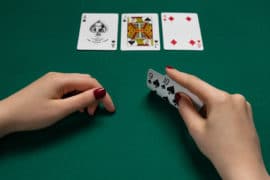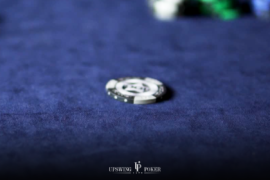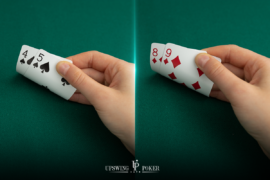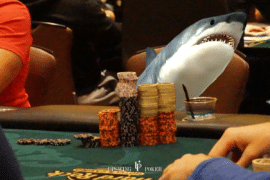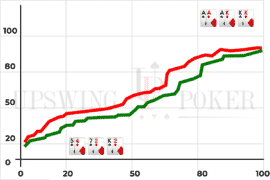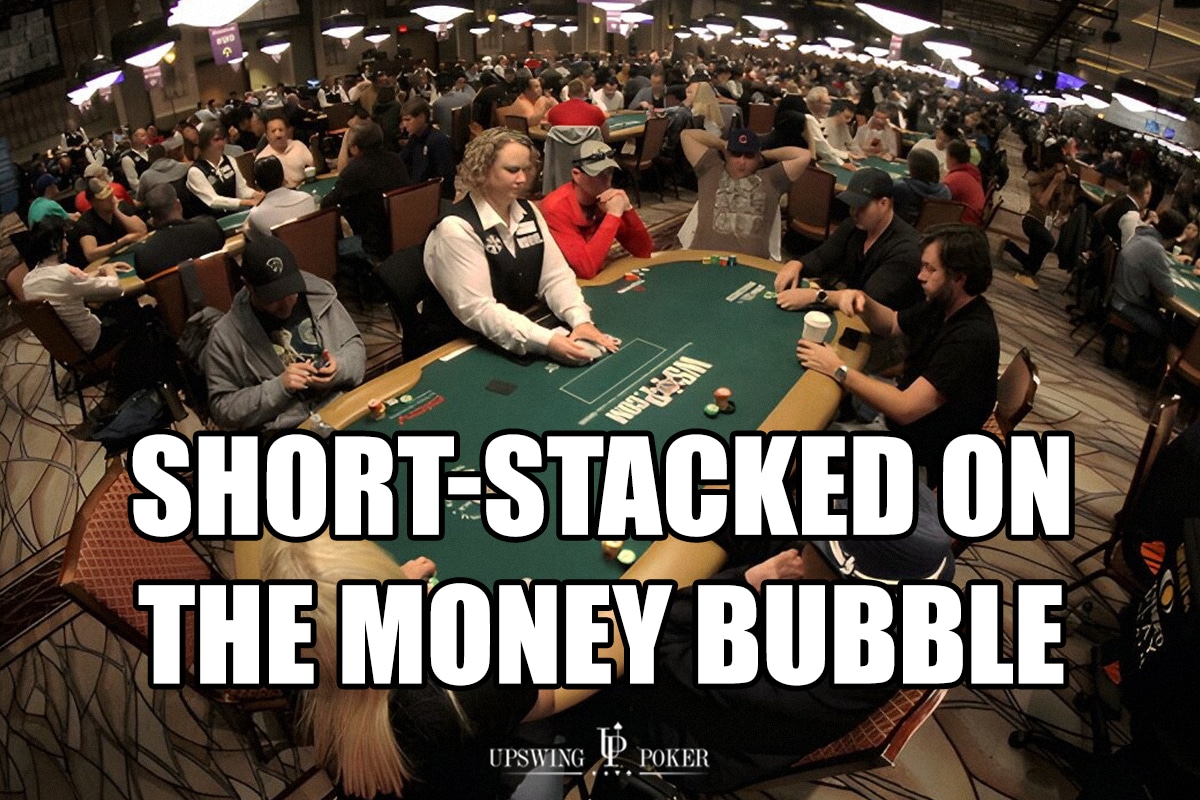
How Short Stacks Navigate the Stone Bubble
Whether you’re a short stack forced all-in and dealt to lose, or one of the big stacks getting coolered for what could have been a mega stack, it doesn’t matter—busting right before the money always feels bad.
In this study, there are 126 remaining players. 125 make the money. We are on the stone bubble. This means the risk premiums will be high, the adjustments extreme, and someone will be leaving disappointed. Hopefully not us.
In my last two articles, the focus was on how raise-first-in (RFI) ranges are affected as the soft bubble emerges and calcifies. In the next two, in addition to RFI strategies, I’ll also be looking at the responses.
For this article, I’ll be using two sets of HRC outputs: one where the table chip leader is Under the Gun and the shortest stack is in the Cutoff, and another where the short stack is Under the Gun and the chip leader is on the Button. Today, the focus will be on short-stack play.
If you haven’t had a chance yet, I highly recommend reading part one (Soft Bubble Strategies) and part two (Money Bubble Tactics) of this series to help orient your reading of today’s article (part 3 of 3).
Short Stack Play
On the stone bubble, some of the most extreme adjustments come from the shorter stacks. This is due to the high risk premiums weighing on them. In ICM, not all chips are equal—each additional chip is worth less than the one before. Conversely, a single chip can be worth the world.
The reason is simple: if you cash with 1bb, you earn the same payout as the player who has 10, 15, or 25bb. Understanding this helps clarify why short stacks play so tight. Yes, they could win more chips by playing profitable chip expected value (chipEV) poker, but doing so could lose money. It’s a classic case of missing the forest for the trees.
Take a look at the HRC output below:
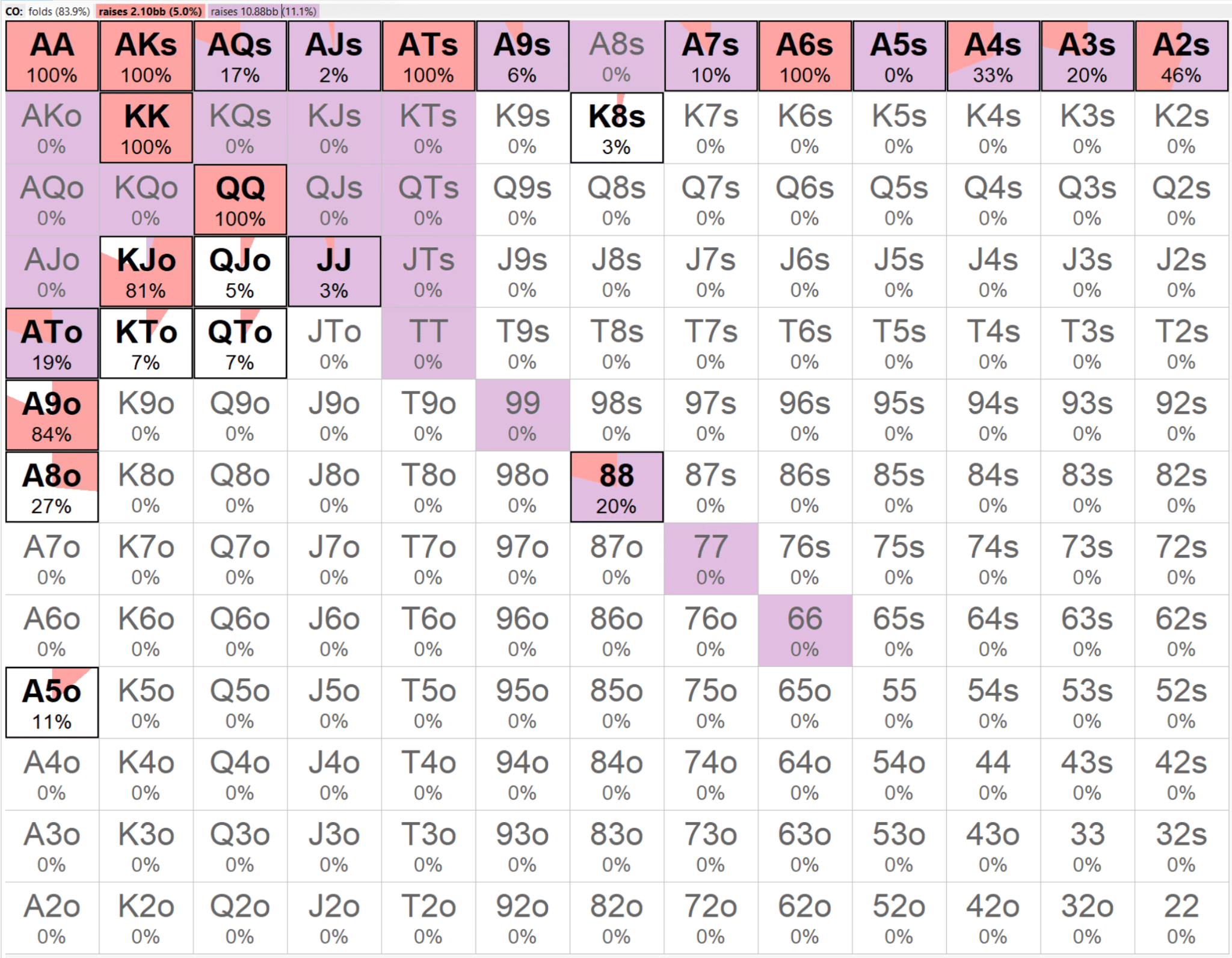
HRC RFI strategy for Cutoff playing an 11bb stack in an asymmetric configuration (28bb average, 1 from ITM). Cutoff vpips 16.1%.
Red: Min open. Purple: Open Shove All In.
Even in late position, the 11bb shorty plays a 16.1% rfi. This is very tight, tighter than a chipEV Under the Gun open range.
On the stone bubble, the late position short stack is open-folding 55, offsuit broadways, and K9 suited. Again, this contraction in range is due to the high risk premium on the Cutoff. See below:
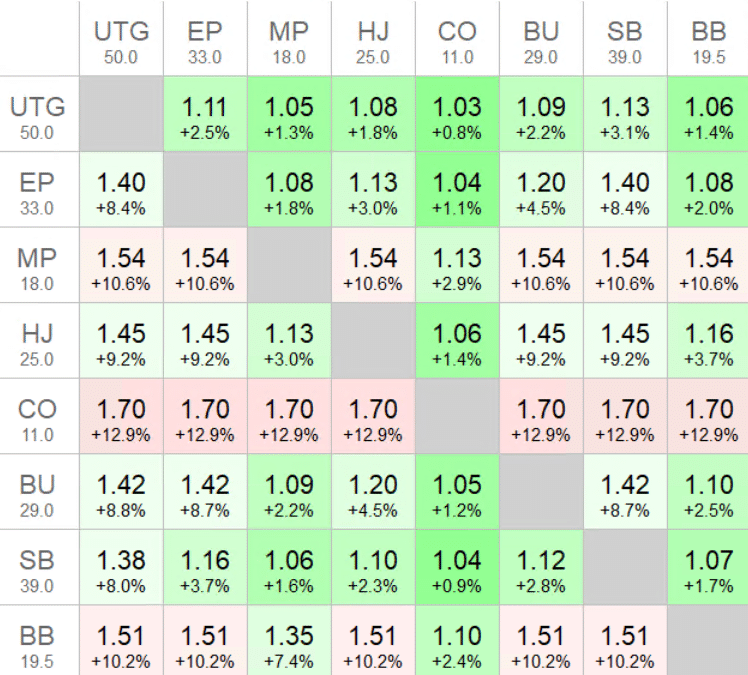
Bubble factors in this setup. The Cutoff (11bb) has a 12.9% risk premium, resulting in playing significantly tighter than chipEV.
Similarly, notice how ICM impacts the Middle Position player and the Big Blind in the chart above. Even though they aren’t exactly “shorties”, they are shorter than the average stack (28bbs) and have meaningful risk premiums against most players at the table. Middle Position has a 10.6% risk premium against almost everyone; likewise, the Big Blind has a 10.2% risk premium versus almost everyone.
Only versus the short stack do both have a significant decrease in risk premium, with Middle Position’s at 2.9% and Big Blind’s at 2.4%. This is because even if they double up the shorty, they live to die another day. For the same reason, Big Blind also has a lower risk premium against Middle Position than against the deeper stacks.
Even if Middle Position gets a full double through Big Blind, Big Blind still has a chip and a chair. But against everyone else, if they stack off, they stone bubble.
Now, let’s look at how things change when the short stack is in early position:
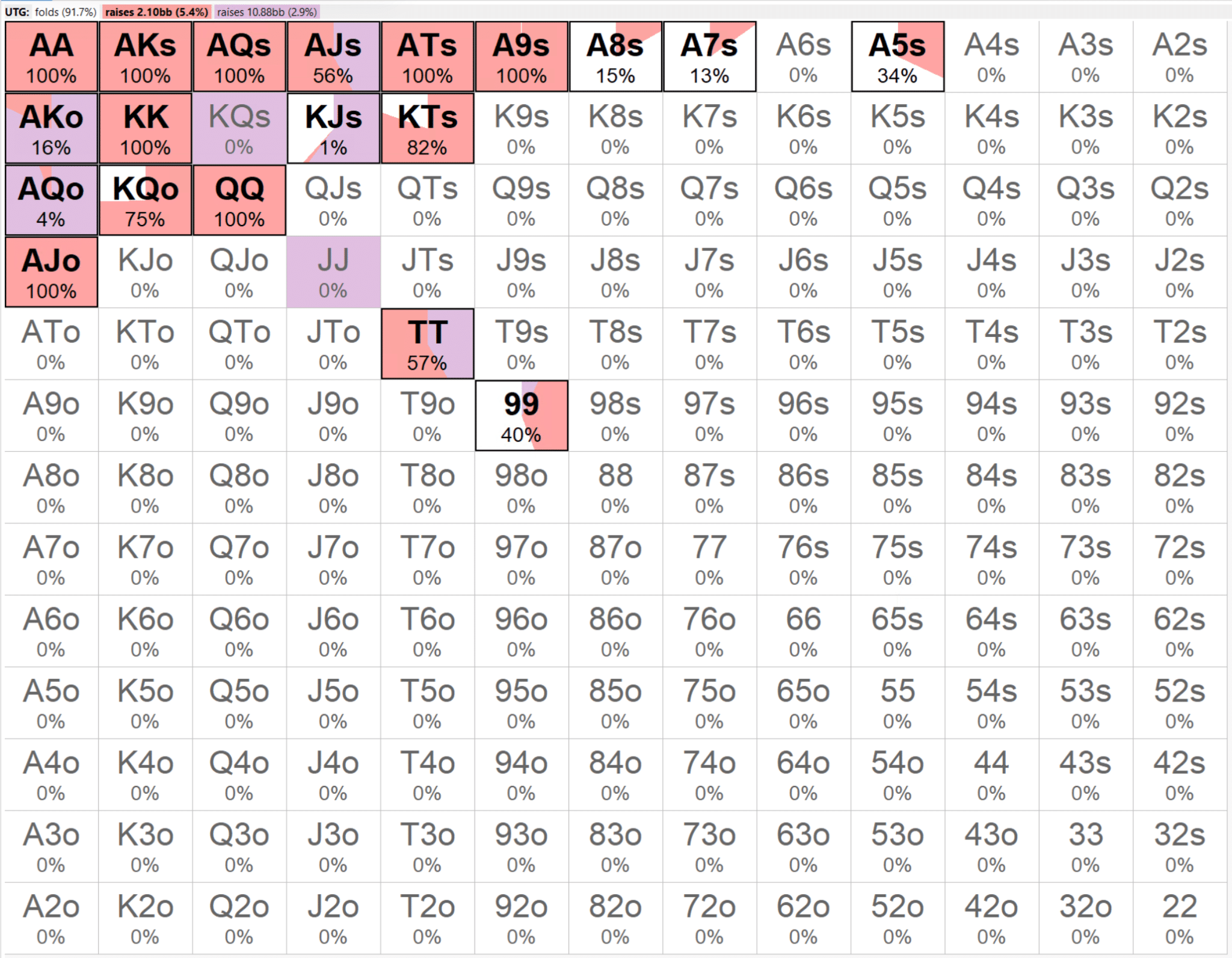
HRC RFI strategy for Under the Gun playing an 11bb stack in an asymmetric configuration (28bb average, 1 from ITM). Under the Gun vpips 8.3%.
Red: Min open. Purple: Open Shove All In.
Now the shorty plays an 8.3% RFI strategy—99 is open-folded more than half the time, and 88 folds pure. Want to be a champion? Try folding 88 off 11bb. It might seem awfully nitty, but take a look below and you’ll see why.

$ Values of Action with 99 in ICM model. When Under the Gun min-opens 99, they make 2 cents. When they raise all-in, they lose 2 cents.
99 only makes $0.02 as an open. That’s incredibly marginal in a $215 tournament, so it mixes to fold. Meanwhile, 88 loses $4.47 when it open-shoves, and slightly more than $2 when it min-opens. These seemingly small dollar losses can add up fast and make it tough to maintain a positive ROI over the long run.
For reference, take a look at what 88 is worth in chips:
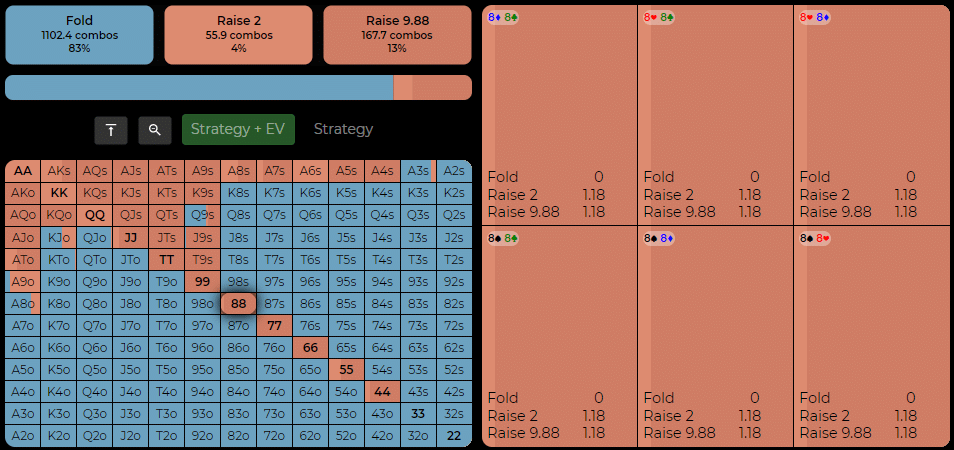
Lucid GTO Trainer preflop chart for 10bb symmetric: Under the Gun. In ChipEV, 88 makes 1.18bb.
88 wins 1.18bb at 10bb effective, but still loses about $4. Once again, this shows that you can win chips while losing money.
How The Table Responds
Below are the responses to the Under the Gun short-stack min-open. Take a look.
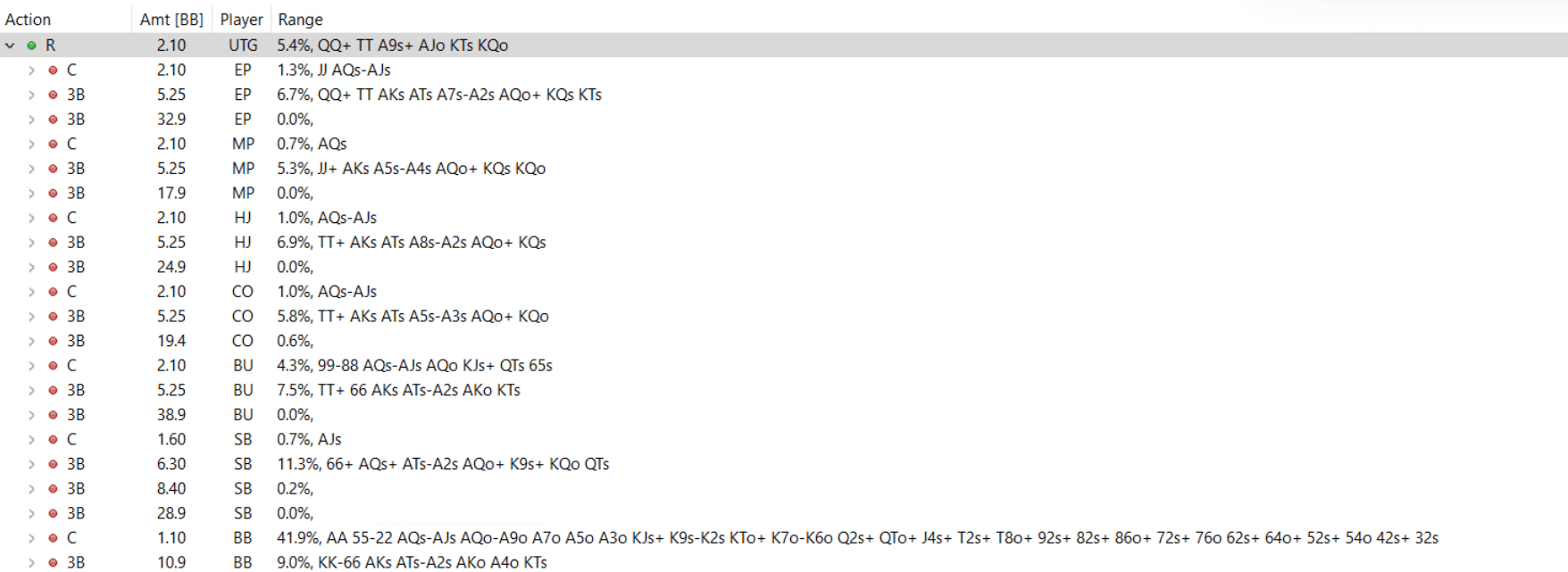
HRC output actions overview showing responses to Under the Gun’s min-open.
Note that only the Big Blind has any significant flatting range (41.9%); the rest of the responses are 3bet, mostly at low frequencies.
A major difference between the Under the Gun and Cutoff strategies is the dominance of min-opening versus open-shoving. The Cutoff short stack shoves about two-thirds of the time and min-opens the rest, knowing they’re likely to get it through with few players behind. Even though they’re short, no one wants to lose chunks of their stack to them unnecessarily.
On the other hand, since the Under the Gun shorty opens so tightly, the rest of the table responds tightly as well. As a result, the opener gets 3-bet infrequently and is called even less. Only the Small Blind has a meaningful 3-bet percentage (11.3%), and that’s because they only play via 3-bet.
The only players the short stack really has to worry about are the Button (50bb), who flats less than 4% and 3-bets over 8%, and the Big Blind, who plays about half the deck. In both cases, however, the investment is significantly less than in chipEV.
Put simply, Under the Gun’s range is so tight that everyone should respond honestly, while the Cutoff bets so much that everyone should respond honestly as well.
What to Do When Your Opponents Are Breaking the Rules
As mentioned in the previous article, your opponents’ responses can cause major shifts in your strategy. When the short stack is focused on survival—and let’s be honest, nobody enjoys the walk of shame back to the registration desk (too bad, it’s the bubble and that desk is long gone)—it becomes crucial to understand how your opponents will actually play, especially when they deviate from what the almighty solver says they should do.
Here are two things to watch for when deciding how to play in real life. And by “real life,” I mean your tournament life.
Wide Big Blind Defense or In-Position Flatting
Some people like to play. Some people like to play back. Whatever the case may be, when you’re an early-position opener on the stone bubble and have a higher risk of seeing flops because your opponents won’t leave you alone, there are countermeasures you can employ.
- Shove More than the Solver: Here, I don’t mean to add hands to your range. I mean that if the $EV is comparable—or even slightly lower—than min-opening but still profitable, jam instead. Even though you have a stronger range, you aren’t thrilled to get action from the weaker one. As flops are seen and pots increase, lowering SPRs, the risk of busting increases as well. There’s no need to be a hero.
- Fold More than the Solver: If the fringe of your range is making marginal $EV as an RFI, its value will dip further once you start facing more calls preflop—sometimes into outright losing territory. It’s not fun, but sometimes you gotta sit out and let the children play.
The One Mistake You Can’t Beat
When your opponents overcall versus your open-shoves, nobody wins. Well—nobody in the hand, at least. The caller isn’t getting the right price against your range, and you’re now at risk more often than you expected when you last checked HRC on your bathroom break… Don’t cheat!!!
The real winners are the onlooking players, who lock up a min-cash more often than they should. In spots like this, you just need your hand to win. Hopefully, you’ve got the top of your jamming range and you hold. Or, you win the flip.
There is a countermeasure, but it’s not sexy.
Once again, you just fold more. I mean fewer hands altogether. You’re in the Cutoff, and you open-fold 66 and JT suited. While these are strong, winning hands, if your opponents are calling too wide (often with an ace or king in their hand), the $EV of these shoves drops. You want to shove in a way that blocks their calls, but more often. Just fold and live to see another hand.
Otherwise, your solver-approved 66 open-shove will leave you muttering on the way out of the card room:
“Calls me with A3 offsuit… what a joke. Nice hand, fish.”
But you know what? It’s not the money that matters. It’s who we become in the pr–
Nevermind.
Until next time.
If you’d like to learn more about how to navigate tricky tournament spots, read: This Greedy Value Bet Strategy Will Help You Win More Tournaments.

